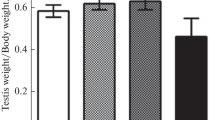Abstract
The effect of right- and left-sided intra- amygdaloid injection of kainic acid on the hypothalamo- hypophyseal-testicular axis was studied in rats. Both right- and left-sided injection of the neurotoxin into the amygdala resulted in a significant decrease in basal testosterone secretion in vitro of both testes and in serum testosterone concentration. In addition, left-sided administration of kainic acid significantly suppressed serum luteinizing hormone level, while right-sided intervention did not alter this parameter. The results of the present study provide further evidence on the involvement of the amygdala in the control of testicular steroidogenesis. Furthermore, the observations suggest functional asymmetry of the amygdala concerning the mechanism of suppressed testosterone secretion.
Similar content being viewed by others
References
Price J.R. The efferent connections of the amygdaloid complex in the rat, cat and monkey. In: Ben-Ari Y. (Ed.), The amygdaloid complex. Elsevier/North Holland, Amsterdam, 1981, p. 125.
Kaada B. Stimulation and regional ablation of the amygdaloid complex with reference to functional representation. In: Elefthesion B.E. (Ed.), The neurobiology of the amygdala. Plenum Press, New York, 1972, p. 205.
Renaud L.P. Influence of amygdala stimulation on the activity of identified tuberoinfundibular neurones in the rat hypothalamus. J. Physiol. (London) 1976, 260: 237–252.
Webber M.P., Hauser W.A., Ottman R., Annagers J.F. Fertility in persons with epilepsy. Epilepsia 1986, 27: 746–752.
Herzog A.G., Seibel M.M., Schomer D.L., Vaitukaitis J.L., Geschwind N. Reproductive endocrine disorders in men with partial seizures of temporal lobe origin. Arch. Neurol. 1986, 43: 347–350.
Edwards H.E., Burham W.M., MacLusky N.J. Partial and generalized seizures affect reproductive physiology differentially in the male rat. Epilepsia 1999, 40: 1490–1498.
Ben-Ari Y., Tremblay E., Ottersen O.P. Injections of kainic acid into the amygdaloid complex of the rat: an electrographic, clinical and histological study in relation to the pathology of epilepsy. Neuroscience 1980, 5: 515–528.
Nadler J.V. Kainic acid as a tool for the study of temporal lobe epilepsy. Life Sci. 1981, 29: 2031–2042.
Ben-Ari Y. Limbic seizures and brain damage produced by kainic acid: mechanisms and relevance to human temporal lobe epilepsy. Neuroscience 1985, 14: 375–403.
Fisher R.S. Animal models of the epilepsies. Brain Res. Rev. 1989, 14: 245–278.
Sperk G. Kainic seizures in the rat. Prog. Neurobiol. 1994, 42: 1–32.
Ben-Ari Y., Lagowaska J., Tremblay E., Le Gal La Salle G. A new model of focal status epilepticus: intraamygdaloid application of kainic acid elicits repetitive secondary generalized convulsive seizures. Brain Res. 1979, 163: 176–179.
Ben-Ari Y., Tremblay E., Ottersen O.P., Naquet R. Evidence suggesting secondary epileptic lesions after kainic acid: pretreatment with diazepam reduces distant but no focal brain damage. Brain Res. 1979, 165: 362–365.
Tanaka S., Kondo S., Tanaka T., Yonemasu Y. Long-term observation of rats after unilateral intra-amygdaloid injection of kainic acid. Brain Res. 1988, 463: 163–167.
Gerendai I., Halász B. Neuroendocrine asymmetry. Front. Neuroendocrinol. 1997, 18: 345–381.
Gerendai I., Halász B. Asymmetry of the neuroendocrine system. News Physiol. Sci. 2001, 16: 92–95.
Galaburda A.M., Geschwind N., Kemper T., LeMay M. Right-left asymmetries of the brain. Science 1978, 199: 852–856.
Amaducci L., Sorbi S., Albanses A., Gainotti G. Choline acetyltransferase (ChAT) activity differs in right and left human temporal lobes. Neurology 1981, 31: 799–805.
Walsh K. Neuropsychology: A clinical approach. Churchill Livingstone, Edinburgh, 1978.
Paxinos G., Watson C. The rat brain in stereotaxic coordinates. Academic Press, San Diego, 1997.
Csernus V. Antibodies of high affinity and specificity for radioimmunological determination of progesterone, testosterone and estradiol-17β. In: Görög S. (Ed.), Advances in steroid analysis. Akadémiai Kiadó, Budapest, 1982, p. 171.
Yamada T., Greer M.A. The effect of bilateral ablation of the amygdala on endocrine function in the rat. Endocrinology 1960, 66: 565–574.
Dreifuss J.J., Murphy J.T., Gloor P. Contrasting effects of two identified amygdaloid efferent pathways on single hypothalamic neurons. J. Neurophysiol. 1986, 31: 237–248.
Zolovick A.J. Effects of lesions and electrical stimulation of the amygdala on hypothalamo-hypophyseal regulation. In: Eleftheriou B.E. (Ed.), The neurobiology of the amygdala. Plenum Press, New York, 1972, p. 745.
Edwards H.E., MacLusky N.J., Burnham W.M. The effect of seizures and kindling on reproductive hormones in the rat. Neurosci. Biobehav. Rev. 2000, 24: 753–762.
Card J.P., Enquist L.W. Use of pseudorabies virus for definition of synaptically linked neurons. Methods Mol. Genet. 1994, 4: 363–382.
Gerendai I., Tóth I.E., Boldogkoi Zs., Medveczky I., Halász B. CNS structures labeled from the testis using the transsynaptic tracing technique. J. Neuroendocrinol. 2000, 12: 1087–1095.
Gerendai I., Csaba Zs., Vokó Z., Csernus V. Involvement of a direct neural mechanism in the control of gonadal functions. J. Steroid Molec. Biol. 1995, 53: 1–6.
Gerendai I., Csaba Zs., Vokó Z., Csernus V. Effect of unilateral deafferentation in the medial basal portion of the temporal lobe on the hypophyseo-ovarian axis in rat: an age-dependent lateralized control mechanism. Brain Res. 1993, 619: 173–179.
Sanchez M.A., Dominguez R. Differential effects of unilateral lesions in the medial amygdala on spontaneous and induced ovulation. Brain Res. Bull. 1995, 38: 313–317.
Banczerowski P., Csaba Zs., Csernus V., Gerendai I. Lesion of the insular cortex affects luteinizing hormone and testosterone of rat. Lateralized effect. Brain Res. 2001, 906: 25–30.
Nance D.M., Moger W.H. Ipsilateral hypothalamic deafferentation blocks the increase in serum FSH following hemicastration. Brain Res. Bull. 1982, 8: 299–302.
Gerendai I., Csaba Zs., Csernus V. Lateralized effect of rightand left-sided vagotomy on testicular steroidogenesis and serum gonadotropin levels in hemicastrated peripubertal rats. Neuroendocrinol. Lett. 1995, 17: 193–198.
Author information
Authors and Affiliations
Corresponding author
Rights and permissions
About this article
Cite this article
Banczerowski, P., Csaba, Z., Csernus, V. et al. Lesion of the amygdala on the right and left side suppresses testosterone secretion but only left-sided intervention decreases serum luteinizing hormone level. J Endocrinol Invest 26, 429–434 (2003). https://doi.org/10.1007/BF03345198
Accepted:
Published:
Issue Date:
DOI: https://doi.org/10.1007/BF03345198



